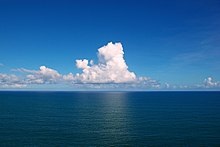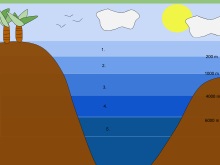|
|
| |
|
|
| |
|
|
|
|
| |
 |
| Surface view of the
Atlantic Ocean. |
Oceans
An ocean is a large area of salt water between
continents. Oceans are very big and they join smaller
seas together. Together, the oceans are like one
"ocean", because all the "oceans" are joined. Oceans (or
marine biomes) cover 72% of our planet. The largest
ocean is the Pacific Ocean. It covers 1/3 (one third) of
the Earth's surface. Big and small fish of different
types are found in oceans. Crabs, starfish, sharks,
whales etc are found in oceans.
The smallest ocean is the Arctic Ocean. Different water
movements separate the Southern Ocean from the Atlantic,
Pacific and Indian Oceans. The Southern ocean is also
called the Antarctic Ocean, because it covers the area
around Antarctica. Older maps may not use the names
Arctic Ocean and Southern Ocean.
The deepest ocean is the Pacific ocean. The deepest
point is the Mariana Trench, being about 11,000 metres
(36,200 feet) deep. The deep ocean is characterized by
cold temperatures, high pressure, and complete darkness.
Some very unusual organisms live in this part of the
ocean. They do not require energy from the sun to
survive, because they use chemicals from deep inside the
Earth (see hydrothermal vent). |
|
 |
| 1. Epipelagic zone:
surface – 200 meters deep 2. Mesopelagic zone:
200 m – 1000 m 3. Bathypelagic zone: 1000 m –
4000 m 4. Abyssopelagic zone: 4000 m – 6000 m 5.
Hadal zone (the trenches): 6000 m to the bottom
of the ocean. |
Color
Although many people believe that the oceans are blue
because the water reflects the blue sky, this is
actually not true. Water has a very slight blue color
that can only be seen when there is a lot of water.
However, the main cause of the blue or blue/green color
of the oceans is that water absorbs the red part of the
incoming light, and reflects the green and blue part of
the light. We then see the reflected light as the color
of water.
Plants and animals
Organisms that live in oceans can live in salt water.
They are affected by sunlight, temperature, water
pressure, and water movement. Different ocean organisms
live near the surface, in shallow waters, and in deep
waters. Small plant organisms that live near the surface
and use sunlight to produce food are called
phytoplankton. Almost all animals in the ocean depend
directly or indirectly on these plants. In shallow
water, you may find lobsters and crabs. In deeper water,
marine animals of many different shapes and sizes swim
through the ocean. These include many types of fish,
such as tuna, swordfish and marine mammals like dolphins
and whales. The skies above the open ocean are home to
large sea birds, such as the albatross.
As it is thought that life evolved in the ocean, the
diversity of life is immense, including: |
- Bacteria : ubiquitous single-celled
prokaryotes found throughout the world
- Archaea : prokaryotes distinct from
bacteria, that inhabit many environments of the ocean,
as well as many extreme environments
- Algae : algae is a "catch-all" term
to include many photosynthetic, single-celled
eukaryotes, such as green algae, diatoms, and
dinoflagellates, but also multicellular algae, such as
some red algae (including organisms like Pyropia, which
is the source of the edible nori seaweed), and brown
algae (including organisms like kelp).
- Plants : including sea grasses, or
mangroves
- Fungi : many marine fungi with
diverse roles are found in oceanic environments
- Animals : most animal phyla have
species that inhabit the ocean, including many that are
only found in marine environments such as sponges,
Cnidaria (such as corals and jellyfish), comb jellies,
Brachiopods, and Echinoderms (such as sea urchins and
sea stars). Many other familiar animal groups primarily
live in the ocean, including cephalopods (includes
octopus and squid), crustaceans (includes lobsters,
crabs, and shrimp), fish, sharks, cetaceans (includes
whales, dolphins, and porpoises).
|
|
In addition, many land animals have adapted to living a
major part of their life on the oceans. For instance,
seabirds are a diverse group of birds that have adapted to a
life mainly on the oceans. They feed on marine animals and
spend most of their lifetime on water, many only going on
land for breeding. Other birds that have adapted to oceans
as their living space are penguins, seagulls and pelicans.
Seven species of turtles, the sea turtles, also spend most
of their time in the oceans. |
|
 |
| The major oceanic
zones, based on depth and biophysical
conditions. |
Harvesting the ocean
Nations like Russia and Japan have lots of huge ships
that go to some of the world's best fishing areas for
many months. These large ships have libraries,
hospitals, schools, repair (fixing) shops and other
things that are needed for fishermen and their families.
Many people look at the sea as a source of food,
minerals and energy.
Fishing
According to the FishBase.org website, there are 33,200
known species of fish, and many of them live in the
oceans. Many of these fish are a fine source of protein,
so many people eat them.
Fishing industries are very important because they make
jobs and give food to millions of people. Today, usually
through ocean fishing, the ocean supplies about 2% of
the calories needed by people.
Tuna, anchovies, and herring are harvested close to the
surface of the ocean. Pollock, flounder and cod are
caught near the ocean floor. More than a million tons of
herring are caught every year in the North Pacific and
North Atlantic, and almost eight fish out of ten fish
are eaten as food for humans. The other fish are used as
fertilizer, glue, and pet and other animal food.
Ocean temperatures
There are many different ocean temperatures in the open
ocean, both vertically (from top to bottom) and
horizontally. Icebergs are made over very cold waters at
either pole, while waters at the equator are pretty
warm. Water cools and warms more slowly than land does,
so land influenced by the ocean has later and milder
seasons than land that is farther away from the ocean.
The surface part of the ocean, also called the mixed
layer, is not much colder even when we go deeper down.
Below this surface zone is a layer of sudden temperature
difference, called a thermocline. This is a middle layer
hat is from the surface zone down to about 2,600 feet
(800 m). Thermoclines may happen only at seasons or
permanently, and may change depending on where and how
deep it is. As evaporation happens, it begins cooling,
and if the water evaporates very quickly, the water
becomes saltier. The salty, cold water is denser, so it
sinks. This is why warm and cold waters do not easily
mix. Most animals and plants live in the warm upper
layer. Below the thermocline, temperature in the deep
zone is so cold it is just above freezing - between 32 –
37.4 F (0 – 3 C). |
|
Extraterrestrial oceans
Although Earth is the only known planet with large
stable bodies of liquid water on its surface and the
only one in the Solar System, other celestial bodies are
thought to have large oceans.
Planets
The gas giants, Jupiter and Saturn, are thought to lack
surfaces and instead have a stratum of liquid hydrogen;
however their planetary geology is not well understood.
The possibility of the ice giants Uranus and Neptune
having hot, highly compressed, supercritical water under
their thick atmospheres has been hypothesised.
Although their composition is still not fully
understood, a 2006 study by Wiktorowicz and Ingersall
ruled out the possibility of such a water "ocean"
existing on Neptune, though some studies have suggested
that exotic oceans of liquid diamond are possible.
The Mars ocean hypothesis suggests that nearly a third
of the surface of Mars was once covered by water, though
the water on Mars is no longer oceanic (much of it
residing in the ice caps). The possibility continues to
be studied along with reasons for their apparent
disappearance. Astronomers think that Venus had liquid
water and perhaps oceans in its very early history. If
they existed, all later vanished via resurfacing. |
|
|
 Kiddle: Oceans Kiddle: Oceans
Wikipedia: Oceans |
|
|
|
|
|
|
|
|
|
|
|
|
|
|
|
|
|
|
Search Fun Easy English |
|
|
|
|
|
|
|
|
|
|
|
|
|
|
|
About
Contact
Copyright
Resources
Site Map |